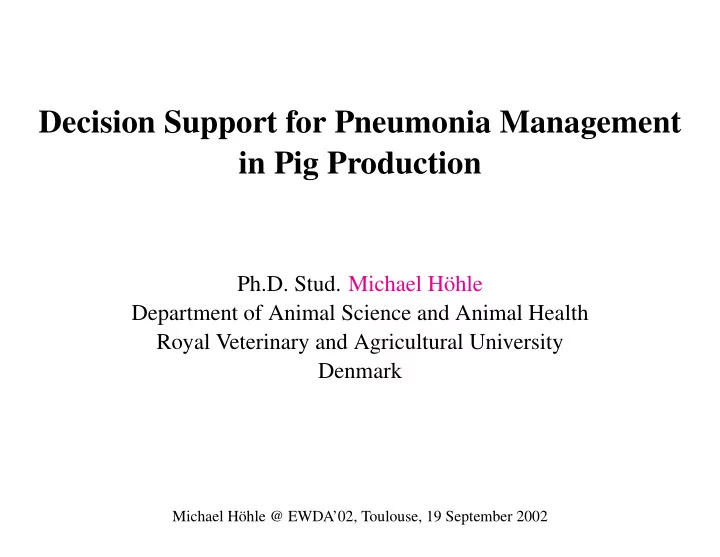

Decision Support for Pneumonia Management in Pig Production Ph.D. Stud. Michael Höhle Department of Animal Science and Animal Health Royal Veterinary and Agricultural University Denmark Michael Höhle @ EWDA’02, Toulouse, 19 September 2002
1 I NTRODUCTION • Aim of work: Exploit on-site treatment recordings to obtain insight and predict the spread of infectious diseases. • Data provided by Danish National Comittee for Pig Production for boar test facility Bøgildgård. • Pneumonia a term the workers use; covers visual detection of symp- toms like panting, dry cough or inactivity. Causes are PRRS, my- coplasma hyopneumonia, pleuropneumonia, etc. Michael Höhle @ EWDA’02, Toulouse, 19 September 2002
2 S PATIO -T EMPORAL I LLUSTRATION OF T REATMENTS • Animation allows to review and analysis the events. S N S 8 2 E n t r a n c e S 1 1 ⋆ A green pen : Pen contains boars the specific day ⋆ A red pen : At least one boar in pen treated. Michael Höhle @ EWDA’02, Toulouse, 19 September 2002
3 T HE T REATMENT S TRATEGY • Instance of sequential decision making under uncertainty. ⋆ Daily decision; today’s choice impacts tomorrow’s state ⋆ State only partially observable due to imprecise tests, etc. • Two treatment regimes ⋆ Individual treatments – injections with anti-biotics for 2-3 days ⋆ Section treatment – anti-biotics in the water supply of the section. • Idea for decision support: Predict occurrence of new cases → risk map. Michael Höhle @ EWDA’02, Toulouse, 19 September 2002
4 C RAFTING THE R ISK M AP • Operate on daily level with section granularity. � 1 if one or more new infections appear in s on day t , Y s t = 0 if no new infections appear in s on day t . • Use parametric model to compute prediction ˆ Y s t + k . • Colorize each section according to ˆ Y s t + k to obtain risk map for day t + k . • Let map aid decisions, s.a. keeping a higher alert level, perform pre- emptive culling, apply water medication, etc. Michael Höhle @ EWDA’02, Toulouse, 19 September 2002
5 L OGISTIC D ISCRIMINATION • Assume prior probabilities π 0 and π 1 for the two states of Y s t and misclassification losses L 01 and L 10 . • Compute posterior p ( Y s t | x t ) by some parametric model using ob- served covariates x t • Minimum loss Bayes rule based on posterior � 1 if p ( Y s t = 1 | x t ) > L 01 / ( L 01 + L 10 ) c ( x t ) = . 0 otherwise Michael Höhle @ EWDA’02, Toulouse, 19 September 2002
6 C LASSIFIER T RAINING AND E VALUATION • Assume 1:1 correspondence between treatment and disease and split dataset into training and validation sets. • Use confusion matrix to calculate misclassification rates. c ( x t ) \ Y t 1 0 n 11 Se = ( n 11 + n 10 ) 1 n 11 n 01 n 00 Sp = ( n 01 + n 00 ) 0 n 10 n 00 • Evaluation metric – expected cost per case p ( Y s t = 1)(1 − Se ) L 10 + (1 − p ( Y s t = 1))(1 − Sp ) L 01 . Michael Höhle @ EWDA’02, Toulouse, 19 September 2002
7 G ENERALIZED A UTOREGRESSIVE M ODEL (1) • Time series model with discrete response conditioned on past. • Histogram plots reveal effect of average age of boars in section, num- ber of boars, and time of the year. 400 400 Number of Treatments Number of Treatments 300 300 200 200 100 100 0 0 0 20 40 60 80 100 120 Jan Mar May Jul Sep Nov Age Time of year Michael Höhle @ EWDA’02, Toulouse, 19 September 2002
8 G ENERALIZED A UTOREGRESSIVE M ODEL (2) • Disease spread is modeled by including state of nearest compass di- rection neighbors. • Resulting logistic link GArM ( l ) model l β s ′ i y s ′ � � logit( µ s x s no γ 1 + x s age γ 2 + γ season t ) = + β 0 + t − i , 3 i =1 s ′ ∈ N ∗ 4 ( s ) • Finding appropriate l is a model selection issue. Michael Höhle @ EWDA’02, Toulouse, 19 September 2002
9 ROC CURVE FOR S 11 – T RAINING S ET 1.0 1/101 0.8 1/11 0.6 Se 0.4 1 7 0.2 3 12 0.0 0.0 0.2 0.4 0.6 0.8 1.0 1−Sp Michael Höhle @ EWDA’02, Toulouse, 19 September 2002
10 ROC CURVE FOR S 11 – V ALIDATION S ET 1.0 0.8 0.6 Se 0.4 1 7 0.2 3 12 0.0 0.0 0.2 0.4 0.6 0.8 1.0 1−Sp Michael Höhle @ EWDA’02, Toulouse, 19 September 2002
11 C ONCLUSION AND D ISCUSSION • Decision aid by predicting location of new cases. • Black-box model is not able to find many systematic patterns in Bøgildgård data. White-box approach s.a. SIR-model might facili- tate data better. • Treatments yield only partial information on disease state. Explicitly modeling this fact might be beneficial, but hard to quantify. • Retrospective analysis immediately useful. Prediction system a step towards the goal of decision support systems in health management. Michael Höhle @ EWDA’02, Toulouse, 19 September 2002
Recommend
More recommend